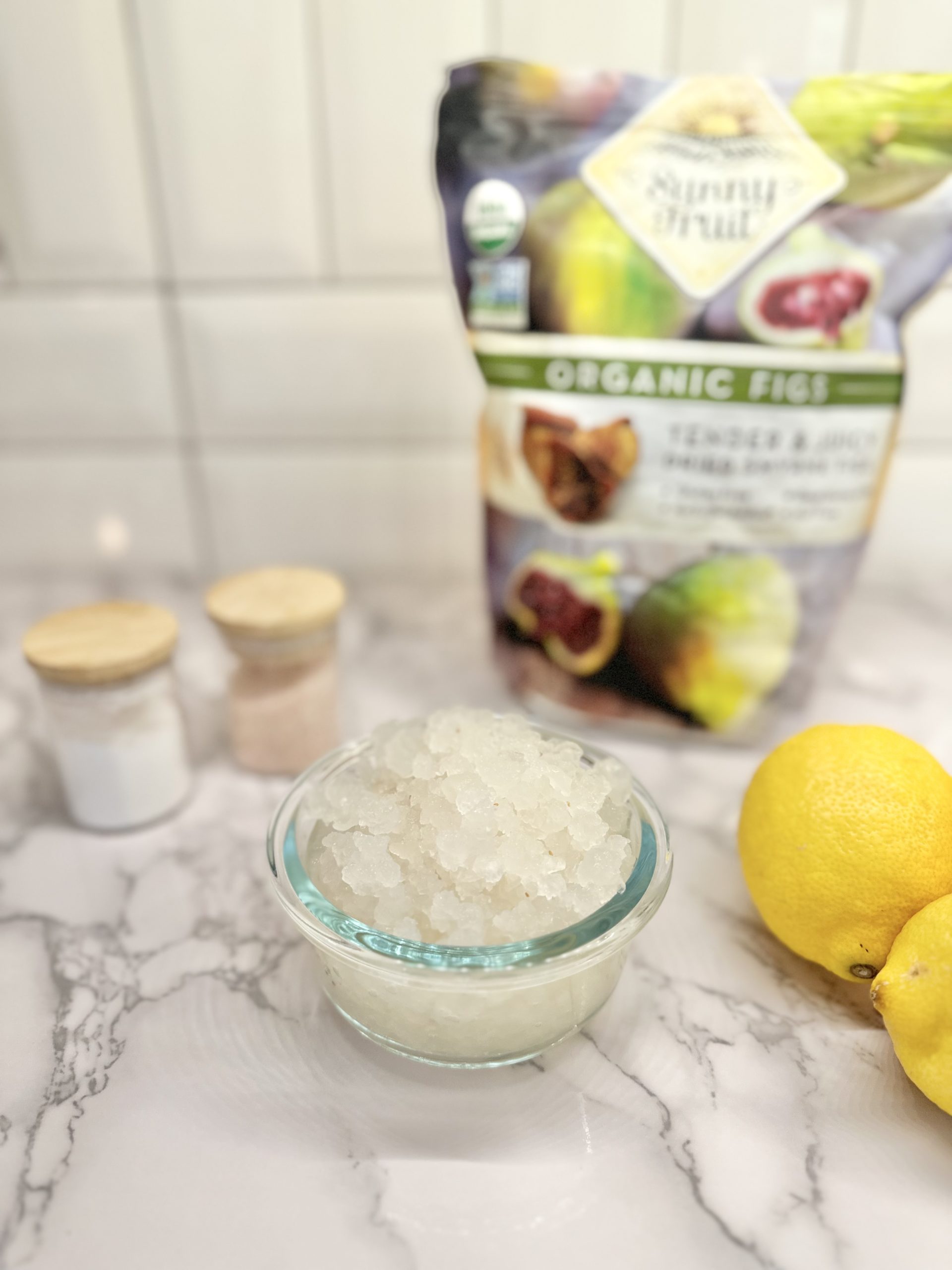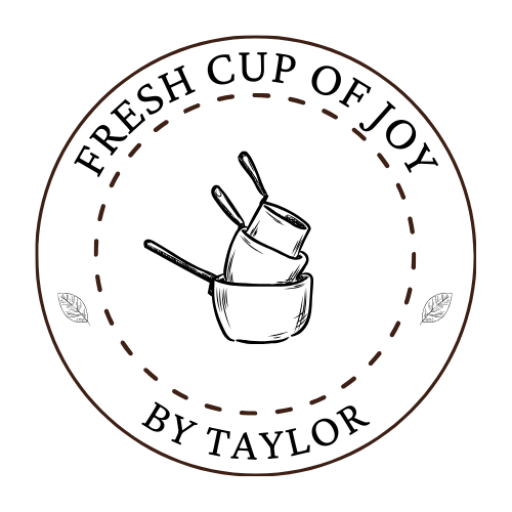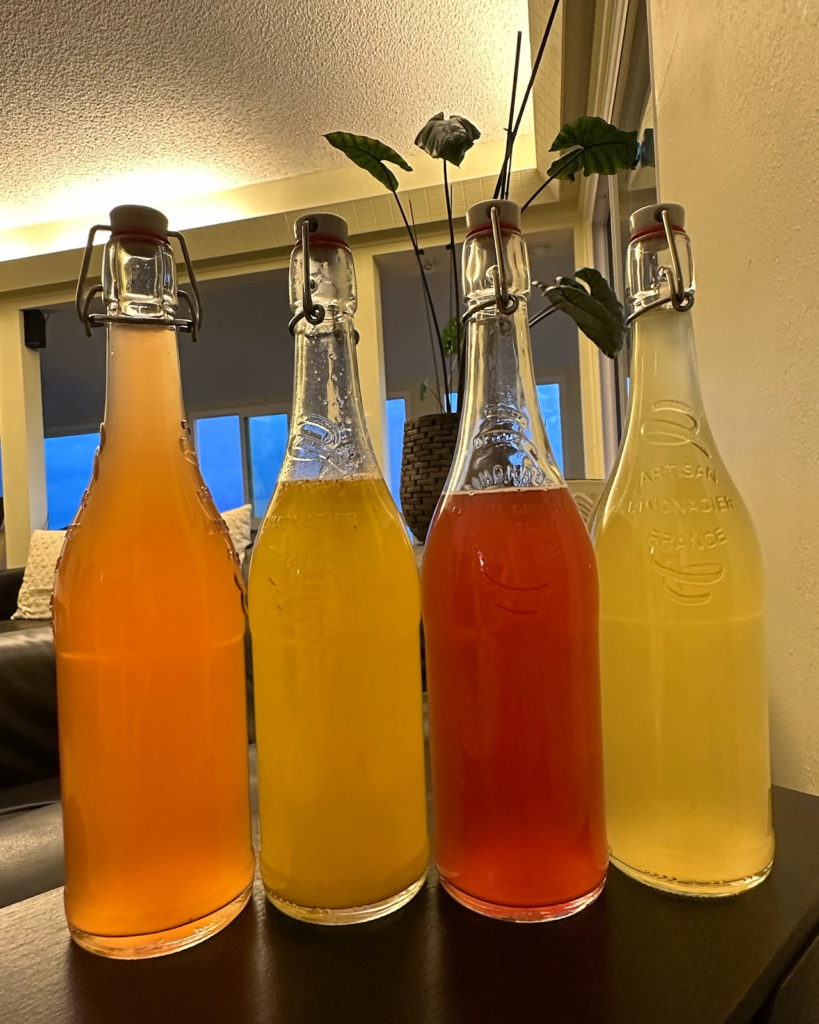
Water Keifer Supplies
- 2- 1 qt. GLASS Mason Jars or Pitchers
- Strainer (preferably plastic) or strainer lids
- Loose cover for top of jar – clean face towel, coffee filter/ rubber band, netted food cover
Ingredients:
- 4 oz (¼ c.) water kefir grains
- 4 c. Water – tap or spring, not alkaline
- 4 oz. (¼ c.) organic raw sugar
Minerals:
- ½ – 1 whole organic Turkish fig
- A pinch of salt (Hawaiian rock salt or any other mineralized salt) and/or baking soda
- Lemon – thick sliced with rind cut off, squeeze into water and drop in
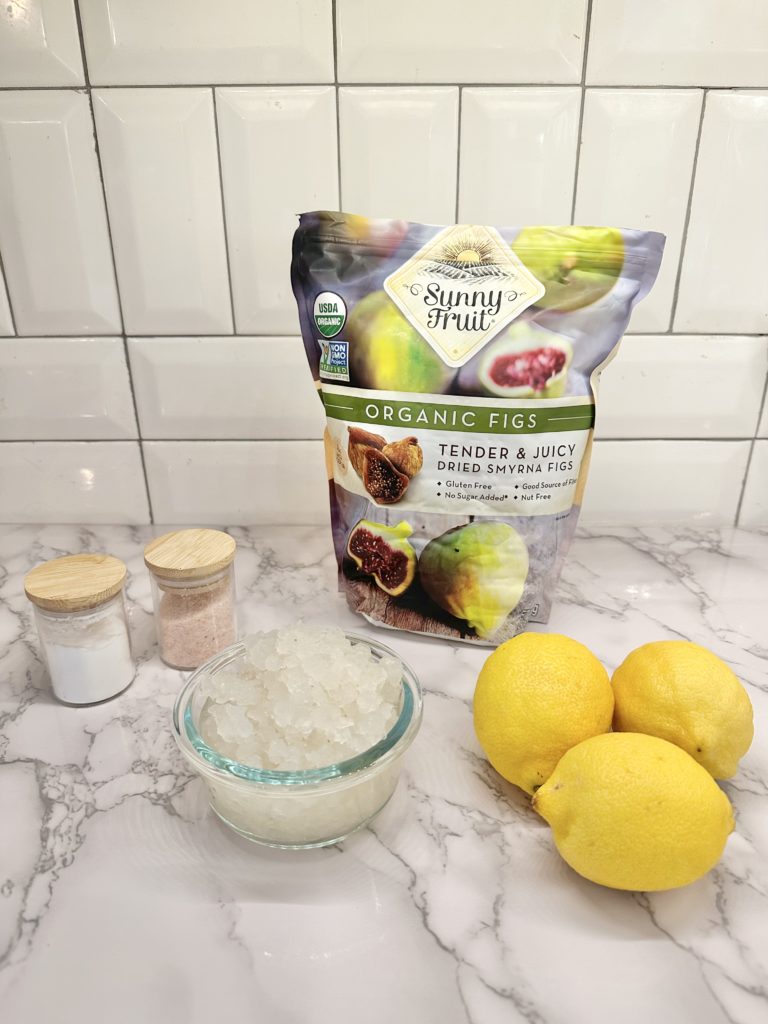
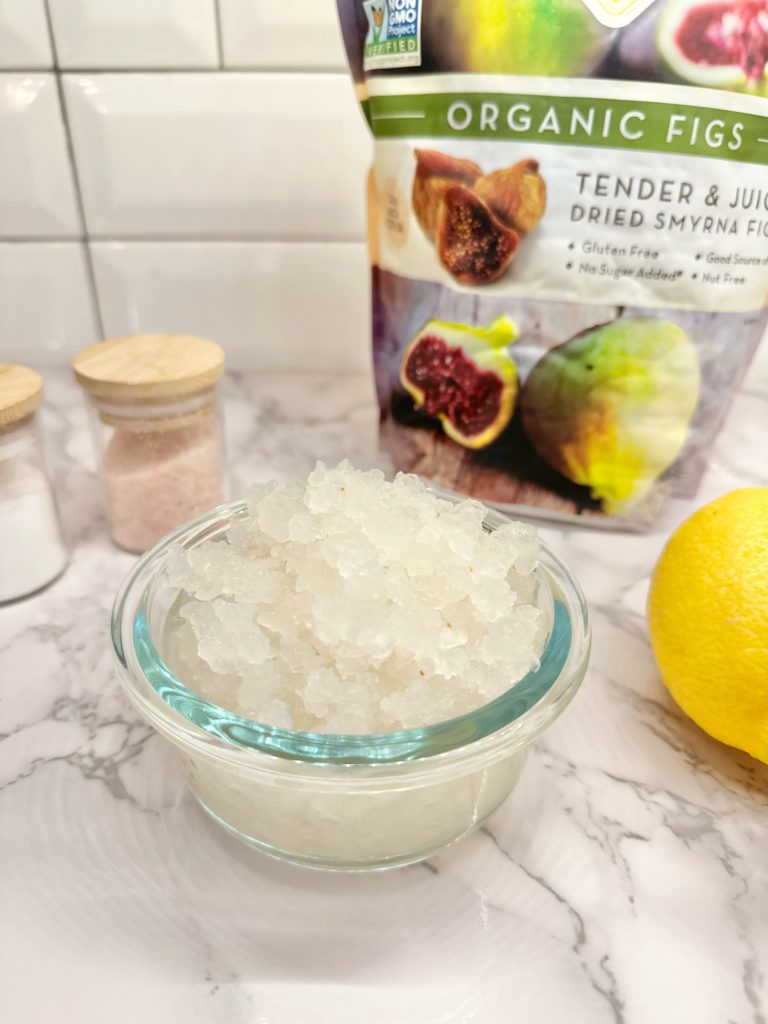
First Fermentation
Unflavored water kefir, slightly carbonated, light yeasty flavor, about 50% less sweet than starting liquid – takes 18 hours to 48 hours depending on ambient air temp (warm house ferments faster)
Fill 1 qt mason jar with water until about 2” from top. Add sugar and stir to dissolve. Add fig, squeezed lemon, salt, baking soda and kefir grains. Top off with water until about .75-1” from top.
Use a plastic spoon to taste the liquid for sweetness – make a mental note. (Note: avoid using metal in the kefir as they interact poorly with the kefir grains. I can’t find a spoon alternative that’s not plastic or metal so just make it quick and don’t leave your spoon in the kefir.)
Loosely cover the container and leave it in on the kitchen counter where you’ll see it and not forget it. Set an alarm to check it in 18 – 24 hours.
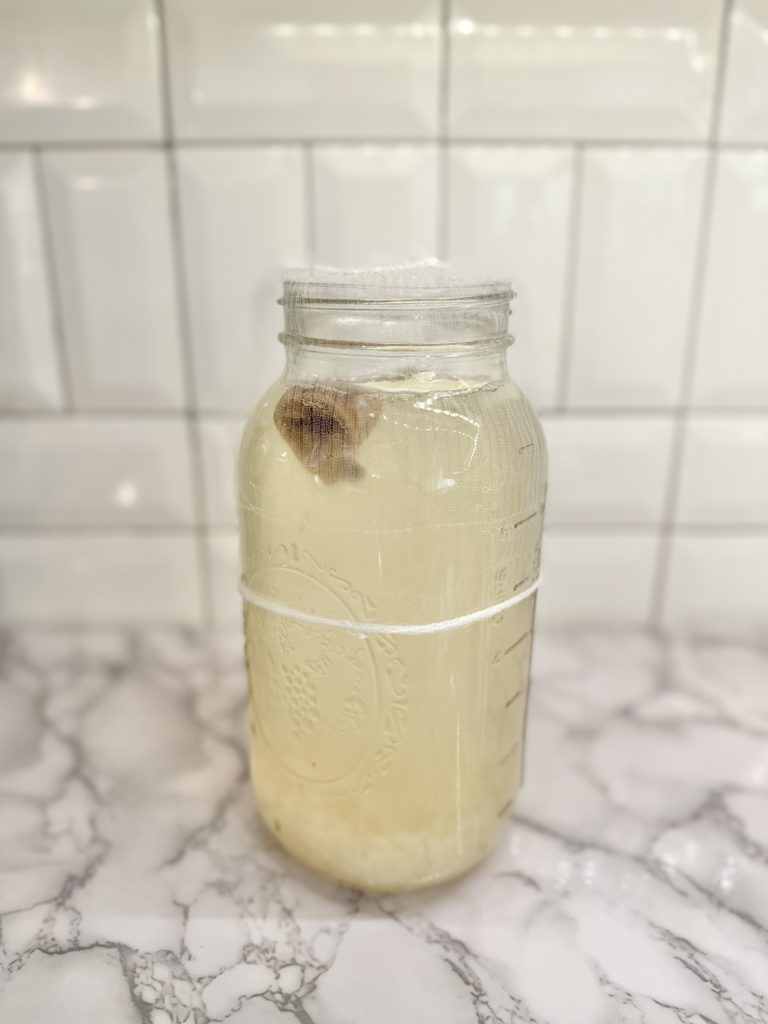
Using a spoon, taste your kefir water. Notice 3 things: 1) sweetness, 2) fizziness, and 3) yeast/ alcohol. it should be slightly carbonated, a little yeasty flavor – like beer, and about ½ the sweetness. If it’s too sweet, let it sit for another few hours and check again.
Once it’s about ½ the sweetness, remove with a chopstick or plastic spoon and toss the fig and lemon.
Find another glass jar or plastic pitcher (real quick switch) and strain your water kefir. Put the grains back into the emptied glass jar and get ready to make your next batch of water kefir, again.
With the strained, fermented water kefir liquid you have the choice to 1) refrigerate it and begin drinking it “as is.” Most people like to labor their kefir by 1) adding fruit juice to it or 2) doing a second fermentation. I like the kefir to consume the fruit sugars so I do the 2nd fermentation.
Second Fermentation
Flavored water kefir that is a little more fermented and will become .5%-1% alcoholic the longer you ferment it at room temperature! Refrigeration slows down the fermentation so you have control over the carbonation and alcohol process.
Frozen berries make awesome flavors – blueberries, strawberries, fresh or frozen mango or pineapple, ginger, turmeric, mint leaves, fruit juices or tea bag. I like this berry blend from Costco. Dump about a ½ c. Of fruits into the water kefir and cover for another 8-24 hours. My favorite flavor is made with the organic frozen berry mix from Costco (below).

Taste the flavored water kefir with a plastic spoon to decide to leave the fruit in longer. When ready, strain and discard the fruit and refrigerate your flavored kefir.

Options – there is a fine line between making flavored kefir SODA or CIDER. Using a swing top bottle or recycled kombucha bottle that is pressure tested. You can’t use just any glass bottle. For example, mason jars are not pressure study and might explode. I buy a carbonated drink at Foodland Market just to repurpose the high quality swing top bottle – made in France with a ceramic top.
For Soda
Pour flavored kefir into the swing top bottle to 1 ½ inch from the top. Seal it and quickly burp and reseal it every few hours for about 18-24 hours. Burp and refrigerate. Be careful when burping the swing top bottles. There is a trick to do this. Quickly pop the handle and relatch it right away before the foam rises to the top.
Water kefir carbonation pressure is no joke!

For Cider:
Do the same as the sofa but add another 12-24 hours to the room temperature 2nd ferment. Keep burping the bottle then refrigerate.
TIPS:
Not Kid Friendly – water kefir has some alcohol content and is not indicated for kids, animals, or pregnant women.
Room Temperature vs. Refrigeration
Ideally, you will have a constant production process of kefir ini various stages of production – 1st fermentation, 2nd fermentation, different flavors of kefir in the fridge in a pitcher with a non-airtight cover that’s a little fizzy but not too much, soda that is fizzier and cider that is like the soda but 🤪. You’ll notice that the kefir grains will start to colonize over time the more you leave them at room temperature. They hibernate when they are in cooler temperatures in the fridge.
Clear, Clean-Flavored Kefir
If you don’t like carbonation or yeastyness, skip the 2nd fermentation. Simply strain the kefir water after the 1st fermentation into a pitcher or (pictured below) small swing top bottles with bits of fresh or frozen juice added, refrigerate, and drink.
Low Carb/Keto Kefir
Substitute 3 tsp. Of organic coconut sugar instead of raw sugar. Coconut sugar is nutritionally the same as organic raw sugar with some added benefits: minerals (i.e, iron zinc, calcium and potassium), poly nutrients and polyphenols – is anti-inflammatory, fiber. It also has a lower glycemic index than refined or raw cane sugar. The added minerals and fiber, along with the salt and lemon, make it a little more like an electrolyte water kefir drink. Adding a few drops of stevia brings the sweetness level up. Don’t be alarmed by the caramel color. It’s a natural color from the coconut sugar. And you won’t detect a coconut flavor. My favorite flavors are fresh lilikoi and fresh lychee.
Storing Extra Grains or Taking a Break
Make a kefir nursery to store extra grains in the refrigerator. Just put your excess grains in a concentrated sugar water mixture with a light cover over the jar. Strain the kefir grains and change the water every few days. If you go on vacation, you can leave your grains in the sugar water for up to 3 weeks. You can also look up how to dehydrate or freeze the grains for longer storage.
Disposing Extra Grains
Share grains with family and friends or feed them to your plants.
None of my ferment times are precise. I don’t set alarms, I just process it when I remember so every batch is different. I also make kefir in larger volume that the 4 c. Recipe. My routine is to make 1 gallon of kefir from starting Friday night and finishing on Sunday morning. This lasts us the week and I’m not fussing with kefir all week. I use different bottles and equipment for this. Let me know if you’d like info. On the equipment I use.
To learn more about the many incredible health benefits of water kefir, check out this post!
Have fun!
Kefir trivia: kefir is considered a superfood. Although milk kefir is superior to water kefir, both kefirs are said to survive stomach acids and make it to your gut where the probiotics continue to work. Whereas, the microorganisms for yogurt and other fermented foods do not survive the digestive process.

